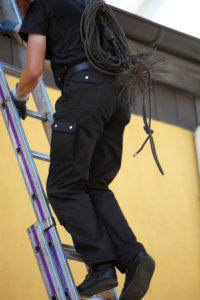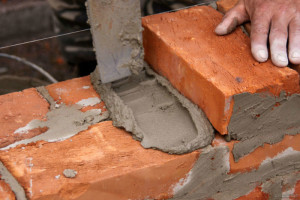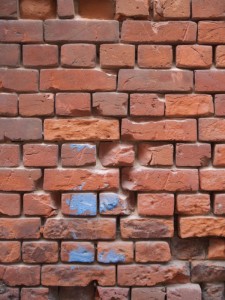Winter in Minnesota arrives sooner, lasts longer, and is significantly colder than many other states. Because of this, fireplaces are often an integral part of keeping our homes – and our families – warm all winter.
While our fireplaces may be used heavily during the fall and winter, many chimney repairs cannot be made in cold weather. This sometimes leads homeowners to rush, hiring the first company they find instead of one that can provide long-term, quality repair.
How masonry damage affects your chimney
Bricks and mortar are built to withstand the elements. However, even the best-constructed chimneys may suffer due to Minnesota’s extremely harsh winters. Because of this, repairs may be necessary to keep the fireplace burning safely and efficiently.
One of the most common causes of masonry damage is the freeze-thaw cycle. The freeze-thaw cycle occurs when small amounts of water become trapped in the bricks and mortar of the chimney. When temperatures drop below zero the water freezes and expands; the creates progressively larger and larger holes and cracks in the chimney.
Finding the right chimney repair company
If the fireplace is not working properly or the chimney is starting to show signs of wear and tear, it is important to have these issues addressed as soon as possible – particularly in a part of the country where winter masonry repairs are often impossible. However, it is still worth the effort to spend time researching a chimney company before hiring. This can help ensure you hire a qualified, trained mason – even if it means waiting until spring to have repairs made.
Things to look for in a masonry repair company
Not all masonry repair companies or chimney sweeps are created equally. Because of this, it is important that homeowners do their research before jumping into repairs with a new company. Unfortunately, this sometimes means waiting until spring until repairs can be made. The following are a few of the things to look for before hiring a masonry repair company.
- Contractor’s license – A reputable repair company should hold a contractor’s license. Not only does this ensure they are qualified to make repairs, but it also protects homeowners; in the event, there is a dispute over the repairs, the state’s dispute resolution program may help compensate homeowners.
- Proof of insurance – Verifying proof of insurance before a chimney company starts making repairs protects both homeowners and workers. For homeowners, insurance ensures you will not be sued in case a worker is damaged as well as protecting you in the event damages are made to the home.
- Reputation and reviews – Most reputable companies are happy to provide potential customers with a list of reviews or referrals. Likewise, the Better Business Bureau or websites like Angie’s List can be helpful in vetting the reputation of potential companies.
In northern states like Minnesota, chimney repairs need to be made before Mother Nature drops the temperature below freezing until spring. However, it is still important to research the company you are hiring before trusting them to work on your fireplace or chimney. For more information on what to look for when hiring a chimney sweep company, contact the CSIA-certified chimney sweeps at Jack Pixley Sweeps today.
There are a number of ways to spot that your fireplace system needs to be repaired; crumbling exterior masonry, leaks, unpleasant odors, or fires that don’t burn correctly are just a few signs that it may be time to call a chimney sweep. However, there is one part of the fireplace that is often ignored, but may need to be repaired – the firebox.

The firebox of your fireplace is built to withstand extremely high temperatures, direct heat from flames, the accumulation of soot and ash, and exposure to smoke and other byproducts of combustion. While extremely sturdy and durable, there are a number of things that can cause damage to the firebox. Because the firebox plays an important role in protecting the surrounding building materials from heat transfer, repairing firebox damage is extremely important.
Causes of firebox damage
Fireboxes are built using special, refractory masonry; this makes them capable of withstanding high temperatures, direct exposure to flames, and other wear and tear from firewood and fireplace use. While designed to safely contain fires for years, there are a number of ways that fireboxes can be damaged. The following are three of the most common cause of firebox damage.
- Settling. All homes – and therefore all chimney systems – are prone to settling. As time passes, the soil surrounding the home can shift and compress; this causes the home to move, or settle, and can lead to cracks in the foundation, walls, chimney, and firebox. Because settling can occur for decades after a home has been built, cracks in the firebox may appear seemingly overnight and progressively get worse over time. Firebox damage caused by settling is often due to footings that cannot bear the full weight of the chimney system.
- Improper building materials. Because the firebox is exposed to direct heat and flame, it is important that special, refractory bricks and masonry is used. If improper building materials were used during firebox construction, the firebox may deteriorate prematurely; surrounding floors, walls, or building materials may experience heat transfer is the firebox was not correctly built. This type of damage can also be seen if a firebox was built by a contractor instead of a trained mason.
- Exposure to moisture. While fireboxes are meant to withstand high heats, they can be severely damaged by exposure to moisture. Water damage is primarily caused by a leak somewhere in the chimney system, but can also occur if water is used to prematurely extinguish fires.
Rebuilding damaged fireboxes
Damaged fireboxes can make it unsafe to use your fireplace; because of this, it is important to have it professionally repaired as soon as possible. Refractory panels with minor damaged may be able to be replaced without rebuilding the entire firebox. In addition to better containing and reflecting heat from the fireplace, replacing refractory panels can help make an aging firebox structurally sound. The masonry joints in the firebox can be repaired through a process called tuckpointing. Tuckpointing involves carefully removing the damaged mortar before applying new mortar to the joints.
Don’t let a damaged firebox prevent you from enjoying your fireplace this winter. Contact the fireplace experts at Jack Pixley Sweeps today for more information on rebuilding your damaged firebox!
Scaffolding isn’t just used for major construction projects; many chimney repairs require scaffolding too. However, only a few chimney companies are certified to set up scaffolding. This means that scaffolding set up is an added expense and a time delay to your chimney repair. At Jack Pixley Sweeps, our team is trained and certified to set up scaffolding. This will help you to save thousands of dollars while also saving you lots of time to keep your chimney repair project right on schedule.
Why being scaffolding set up certified matters
While scaffolding may look simple, setting it up is very complex. It can affect the safety of the chimney technicians and the stability of the repairs as well. Because of this, it is extremely important that the crew sets up the scaffolding is trained and certified.
At Jack Pixley Sweeps, our crews are trained in the proper setup of both ground and roof scaffolding. All of our repair technicians have been through Occupational Safety and Health Administration (OSHA) training. Our scaffolding always meets safety standards. This ensures the safety of the crew, the safety of your family during the chimney repair process, and the structural stability of your chimney as well.
The scaffolding set up process
Setting up scaffolding is unique to every house. It depends on the location and height of the chimney, the repairs required, the pitch of the roof, and more. This can all influence how your scaffolding is constructed. Because scaffolding is customized for each home and job, setting up can take between two and four hours.
When scaffolding is set up, it is required to be “tied off” or anchored to the home, every 20 feet. Oftentimes, scaffolding can be tied off onto the chimney. However, some cases it may needs to be anchored to the home itself using anchor bolts. Likewise, roof scaffolding is also required to be anchored to the roof using anchor bolts. Once properly anchored, then height can be added to the scaffolding structure.
Trust Jack Pixley Sweeps to set up your scaffolding!
Being able to set up our own is a direct benefit to you. This eliminates the need to find a subcontractor to help with scaffolding, which then save you time and money! Because our repair crews set up and maintain their own scaffolding, homeowners can also rest assured that the only people coming to the job site are our employees.
If you are preparing to have some major chimney repairs such as, rebuilding a chimney from the ground up or adding a new chimney onto your home. You should definitely take scaffolding into considerations, as it contribute to the safety and structural stability of the project. It is extremely important to work with a trained and certified team to set up your scaffolding. For more information on our professional scaffolding set up services contact Jack Pixley Sweeps today!
With warmer temperatures finally here and summer just around the corner, many of us are content to close up our fireplaces until fall. However, if your chimney needs masonry repairs now may be the best time to have them done!

What causes masonry damage?
While bricks and mortar are one of the strongest building materials on the planet, they cannot stand up to everything. Because of this, there are a number of things that can damage your masonry. One of the most common causes of masonry damage is water. Long term exposure to moisture, such as puddles of standing water on the chimney or areas that sprinklers hit with every pass, are at greater risk of damage such as cracking and spalling. This type of damage can often be exacerbated by winter weather conditions; this is why masonry damage is more commonly discovered in the spring.
Signs of masonry damage
Masonry damage can be as minor as a small crack in the mortar or as major as entire chunks of brick or stone falling away from the structure. While a chimney inspection is often needed to pinpoint small areas of damage, the following are signs that your masonry may need to be repaired.
– Chips or cracks
– Missing pieces of bricks or mortar
– Stained masonry
– Long-term growth of ivy or other climbing plants on masonry
– Chimney leaks
Why should I schedule my masonry repairs now?
While spring might not be known as a time of heavy fireplace use, it is often the best time to have your masonry repaired. Below are some of the reasons why you should think ahead and schedule your masonry repairs today.
– Flexible scheduling: Spring is often considered the “off season” for chimneys. Because of this, it is easier to get a flexible appointment time that fits into your busy schedule.
– Mild temperatures: Many masonry repairs require mild temperatures and weather in order to be done. Because of this, some repairs cannot be completed in the cold of winter or the heat of summer, giving spring the ideal weather conditions for repairs.
– Ready to use: If you have your masonry repaired in the spring when you are not regularly using your fireplace, it will be ready to go again the fall when temperatures begin to fall. This gives you the advantage of a fireplace that is ready to use as soon as the first cold snap arrives.
Our masonry services
At Jack Pixley Sweeps, we can clean your chimney inside and repair your masonry outside. We are proud to offer our customers a wide range of masonry services that will keep your fireplace system looking beautiful and burning safely. Our skilled masons can handle any chimney repair, from small areas of tuckpointing or flashing repair to rebuilding your chimney from the ground up.
Don’t put off your masonry repairs until fall. Instead, schedule your masonry work this spring to get the best appointment flexibility and have your fireplace ready to use again in the fall. Contact Jack Pixley Sweeps today to schedule your masonry work today!
During the hot spring and summer months, most homeowners pay little attention to their chimneys. However, now is the best time to have your chimney maintenance and repairs done, especially if your chimney is in need of masonry repairs.
During the winter, fireplaces and chimneys endure months of heavy use and abuse. Coupled with exposure to freezing temperatures and other winter conditions, most chimney systems are in need of maintenance at the end of the season.
 If your chimney or fireplace needs masonry repairs, now is the perfect time to have them done!
If your chimney or fireplace needs masonry repairs, now is the perfect time to have them done!
How masonry gets damaged
There are a number of ways that your chimney’s masonry may be damaged. Below are some of the most common causes of masonry damage.
Water: Moisture is one of the most damaging forces to your chimney and fireplace. While bricks and mortar are designed to stand up against water, repetitive damage from rain or leaks can cause masonry to crack or spall. The masonry in the firebox is particularly susceptible to water damage from chimney leaks; these bricks are designed to withstand high heats, not exposure to water.
Settling: All homes settle over time. However, if your fireplace was not built on a proper foundation this can cause it to crack or shift. Masonry damage from settling is often seen as cracks in the firebox or tilting or uneven chimneys. Chimneys that have been damaged by settling should be repaired as soon as possible to ensure they are stable and safe.
Other damage: While masonry is sturdy, it can be easily damaged if not correctly cared for. One cause of masonry damage that homeowners often forget about is power washing. Attempting to clean your chimney with a power washer can leave your bricks chipped, cracked, spalled, and in need of repair. Similarly, non-breathable sealants or paints that are not designed for use on masonry can actually further damage your chimney instead of protecting it.
Why have your masonry repaired now
Masonry damaged should ideally be repaired as soon as it is found. If you have existing or ongoing masonry damage, however, the summer is a great time of year to have your masonry repaired. Below are three reasons to have your masonry repaired before the fall.
1. Less fireplace use: As the temperatures outside climb, most homeowners are less likely to want to use their fireplaces. Because of this, you would not be inconvenienced or unable to use your fireplace when wanted when having it repaired now as to in the summer.
2. Fewer weather delays: Masonry repairs during the fall are often delayed by weather issues. Likewise, some masonry repairs cannot be performed in cooler temperatures, making them difficult – if not impossible – to complete in the fall or winter.
3. Less wait time: The fall is the most popular time of year for chimney maintenance and repairs. Because of this, it can be extremely difficult to get an appointment at a convenient time. Having your masonry repaired in the summer allows you to schedule the appointment when you want it rather than waiting weeks for an available time.
If you have masonry repairs that need to get done, don’t wait until fall. Let our expert masons take care of your chimney so it is ready to use when the temperatures drop. Call Jack Pixley Sweeps at 763-422-0481 today to schedule your masonry appointment!




